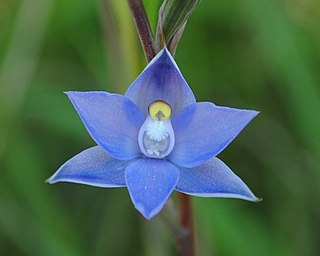
Thelymitra nuda, commonly known as the plain sun orchid is a species of orchid that is endemic to eastern Australia. It has a single fleshy, channelled leaf and up to twelve dark blue to purplish, sometimes white or pinkish flowers with white tufts on top of the anther. It grows in a range of habitats and sometimes forms large colonies.
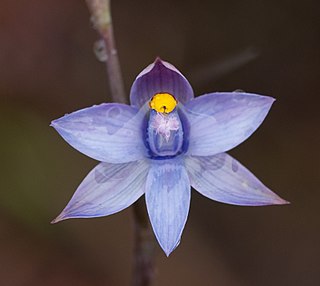
Thelymitra malvina, commonly called the mauve-tufted sun orchid, is a species of orchid that is native to eastern Australia and New Zealand. It has a single large, fleshy leaf and up to twenty five blue to mauve flowers with pink or mauve tufts on top of the anther.
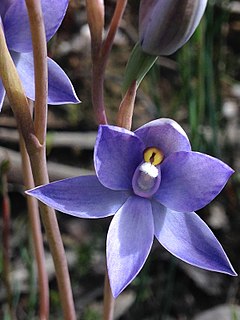
Thelymitra megacalyptra, commonly called the plains sun orchid, is a species of orchid that is endemic to eastern Australia. It has a single erect, fleshy leaf and up to fifteen blue to purplish, sometimes lilac, pink or white flowers with white tufts on top of the anther. It is known as Thelymitra megcalyptra by some authorities.

Thelymitra basaltica, commonly called the grassland sun orchid, is a species of orchid that is endemic to Victoria. It has a single fleshy, channelled, dark green leaf and up to eight small pale blue, self-pollinating flowers which open only slowly on warm to hot days.
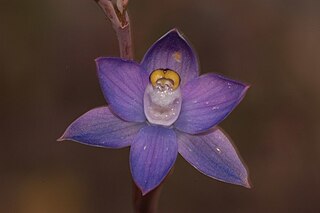
Thelymitra batesii, commonly called the plump sun orchid, is a species of orchid that is endemic to South Australia. It has a single fleshy, channelled, dark green leaf and up to eight mauve to bluish purple flowers that are pinkish with darker stripes on the back. The unopened flower buds are distinctly plump.
Thelymitra exigua, commonly called the short sun orchid, is a species of orchid that is endemic to south-eastern Australia. It has a single fleshy, channelled, dark green leaf and up to eight relatively small pale blue flowers with white toothbrush-like tufts on top of the anther.

Thelymitra holmesii, commonly called the blue star sun orchid, is a species of orchid that is endemic to south-eastern Australia. It has a single long, narrow, fleshy leaf and up to nine purplish blue to mauve flowers with a deeply notched lobe on top of the anther.
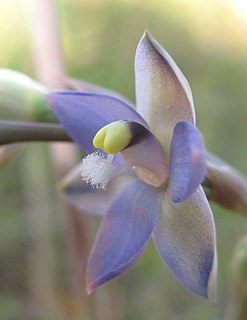
Thelymitra peniculata, commonly called the trim sun orchid, is a species of orchid that is endemic to southern eastern Australia. It has a single long, erect, fleshy, channelled leaf and up to eighteen deep blue to purple self-pollinating flowers.
Thelymitra xanthotricha, commonly called the yellow tufted sun orchid or yellow tufted slender sun orchid, is a species of orchid in the family Orchidaceae and endemic to the south-west of Western Australia. It has a single erect, fleshy, channelled, dark green leaf and up to six relatively large dark blue to purplish flowers.
Thelymitra inflata, commonly called the inflated sun orchid, is a species of orchid that is endemic to south eastern Australia. It has a single long, erect, linear leaf and up to six dark blue to purplish flowers with a very inflated lobe on top of the anther.
Thelymitra lucida, commonly called the glistening sun orchid, is a species of orchid that is endemic to south eastern Australia. It has a single erect, fleshy leaf and up to seven dark blue flowers with the sepals a lighter blue than the petals.

Thelymitra mucida, commonly called the plum sun orchid or plum orchid, is a species of orchid that is endemic to southern Australia. It has a single erect, fleshy, linear leaf and up to six blue, purplish or plum coloured flowers with a thick, sticky secretion on the anther lobe.
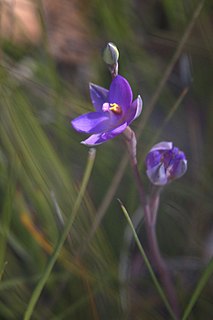
Thelymitra adorata, commonly called the Wyong sun orchid or praying sun orchid, is a species of orchid that is endemic to a very small area of New South Wales. It has a single relatively large, erect, fleshy, channelled leaf and up to thirteen deep blue, self-pollinating flowers.
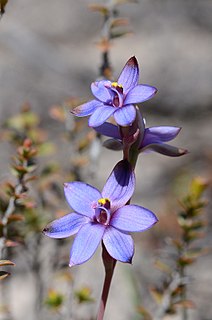
Thelymitra azurea, commonly called the azure sun orchid, is a species of orchid that is endemic to south-eastern Australia. It has a single fleshy, grass-like leaf and up to ten dark azure blue flowers with darker veins. The lobe on top of the anther has a toothed or warty tip.
Thelymitra jonesii, commonly called the skyblue sun orchid, is a species of orchid that is endemic to Tasmania. It has a single erect, fleshy, linear, dark green leaf and up to six relatively small light blue to azure blue flowers with darker veins. It is a rare orchid known from only four scattered locations in moist coastal heath.
Thelymitra latiloba, commonly called the wandoo sun orchid or wandoo shirt orchid, is a species of orchid in the family Orchidaceae and endemic to the south-west of Western Australia. It has a single erect, fleshy, channelled, dark green leaf and up to twelve blue flowers with darker blue veins and sometimes flushed with mauve. The lobe on top of the anther is wavy.
Thelymitra occidentalis, commonly called the western azure sun orchid or rimmed orchid, is a species of orchid in the family Orchidaceae and is endemic to the south-west of Australia. It has a single erect, fleshy, channelled, dark green leaf and up to fifteen blue flowers with darker blue veins and sometimes flushed with pink. The lobe on top of the anther has a wavy, yellow crest.
Thelymitra alpicola, commonly called the alpine striped sun orchid, is a species of orchid that is endemic to eastern Australia. It has a single erect, dark green grass-like leaf and up to six relatively large, deep purplish blue flowers with darker streaks. It grows in subalpine to montane habitats.
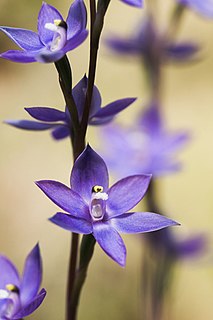
Thelymitra alpina, commonly known as the mountain sun orchid, is a species of orchid that is endemic to south-eastern Australia. It has a single dark green leaf with a purplish base and up to twenty, usually blue to purplish flowers. It grows in alpine, subalpine and montane areas of New South Wales, the Australian Capital Territory and Victoria.
Thelymitra atronitida, commonly called the black-hooded orchid, is a species of orchid that is endemic to south-eastern Australia. It has a single erect, leathery, leaf and up to eight moderately dark blue, self-pollinating flowers that only open on hot days.











